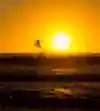
Kitesurfing
With the 2025 Red Bull King of the Air confirmed, we see what it takes to coax the infamous south-easterly wind known as the 'Cape Doctor' out to play.
Red Bull King of the Air 2025 is set to take place between November 22 and December 7. Get the latest event info here.
The weather window for the world's most badass, big air kitesurfing contest opens on November 22, 2025, as the best in the business return to South Africa for Red Bull King of the Air. Why a weather window? To get big air, you need big wind. It's simple, really. But not that simple. Check out the video above, then read on to find out more.
“There is not a minimum limit of wind speed needed to give a ‘go' to the event,” explains Red Bull King of the Air Sportive Director Sergio Cantagalli who makes the call to run the event after consulting extensively with a pro meteorologist and local crew members.
“Ideally – and unless straggled for unexpected reasons – we'll hardly consider any wind below an average of 25 knots (46kph) to start with, and with a forecast to rise to 35 to 37 knots (65 - 69kph), if not more,” he says.
According to Sergio, the ideal wind direction for Kite Beach is the proverbial 'Cape Doctor' south-easterly.
“The prevailing weather in summer comprises the South Atlantic High pressure system sitting a lot more south,” explains weather guru, professional surf forecaster and founder of Wavescape.co.za, Steve ‘Spike’ Pike.
“Cape Town is situated along the eastern edge of this anti-cyclonic system. Simplistically, the counter-clockwise flow around the high forms the basis for the south-east trade wind that blows during summer. The dry, denser air that creates the high pressure also means sunny, dry weather.”
To radically paraphrase the climatology - warm, sunny days and consistent, strong winds.
Pike continues: “The interplay between areas of high and low atmospheric pressure form the basis for ocean weather patterns. High pressure (above 1,013mb) comprises cool dry air that is sinking (creature more pressure on the sea surface). The air around high pressure moves counter-clockwise. Low pressure (below 1,013 mb) is warm air that is rising. Air around the low moves clockwise. Air moves from High pressure towards Low pressure (to replace the rising air) and this creates wind. As the land heats up, more air is rising off the land and the pressure gradient between the two increases, making the air flow faster, and therefore the wind stronger, which is why the SE is often at its strongest in the afternoon.”
Unlike most European countries, which go totally flat for months in their summer season, South Africa has plenty of swell during summer
The west coast section of Cape Town – from Milnerton, up past Table View, Big Bay and beyond – runs in a similar direction to the south-east wind, meaning the winds are blowing across the beach, not onshore or offshore. "This means that the riders can tap the wind back and forth parallel to shore, riding across the nearshore surf line,” Spike says.
This also means they can power up along the wave face for long periods of time, creating epic wave-riding opportunities. “Unlike most European countries, which go totally flat for months in their summer season, South Africa has plenty of swell during summer.”
Well there you go, now you know why you’ll hear more German and Dutch than Afrikaans on the Weskus this summer. Catch the world's best big air kiteboarders as they compete for the crown of Red Bull King of the Air when the event weather window opens on November 22, 2025.
Watch a replay of 2024's action below:

Download the free Red Bull TV app and catch the kitesurfing action on all your devices! Get the app here









